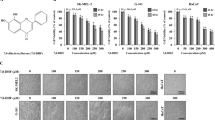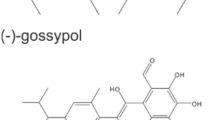Abstract
Aloin, a natural anthracycline from aloe plant, is a hydroxyanthraquinone derivative shown to have antitumor properties. This study demonstrated that aloin exerted inhibition of cell proliferation, adhesion and invasion abilities of B16-F10 melanoma cells under non-cytotoxic concentrations. Furthermore, aloin induced melanoma cell differentiation through the enhancement of melanogenesis and transglutaminase activity. To improve the growth-inhibiting effect of anticancer agents, we found that the combined treatment of cells with aloin and low doses of cisplatin increases the antiproliferative activity of aloin. The results suggest that aloin possesses antineoplastic and antimetastatic properties, exerted likely through the induction of melanoma cell differentiation.





Similar content being viewed by others
References
Albini A, Iwamoto Y, Kleinman HK, Martin GR, Aaronson SA, Kozlowski JM, McEwan RN (1987) A rapid in vitro assay for quantitating the invasive potential of tumor cells. Cancer Res 47:3239–4325
Baker AH, Edwards DR, Murphy G (2002) Metalloproteinase inhibitors: biological actions and therapeutic opportunities. J Cell Sci 115:3719–3727
Balasubramanian S, Eckert RL (2007) Keratinocyte proliferation, differentiation and apoptosis-differential mechanisms of regulation by curcumin, EGCG and apigenin. Toxicol Appl Pharm 224:214–219
Baldini PM, Lentini A, Mattioli P, Provenzano B, De Vito P, Vismara D, Beninati S (2006) Decrease of polyamine levels and enhancement of transglutaminase activity in selective reduction of B16-F10 melanoma cell proliferation induced by atrial natriuretic peptide. Melanoma Res 16:501–507
Cantwell-Dorris ER, O’Leary JJ, Sheils OM (2011) BRAFV600E: implications for carcinogenesis and molecular therapy. Mol Cancer Ther 10:385–394
Chung JH, Cheong JC, Lee JY, Roh HK, Cha YN (1996) Acceleration of the alcohol oxidation rate in rats with aloin, a quinine derivative of Aloe. Biochem Pharmacol 52:1461–1468
Di Giacomo G, Lentini A, Beninati S, Piacentini M, Rodolfo C (2009) In vivo evaluation of type 2 transglutaminase contribution to the metastasis formation in melanoma. Amino Acids 36:717–724
El-Sawy W, Abou-Taleb F, Abdel Kader M, Abdulla M, Abo-El-Magd Y, Gharib A et al (2002) Feasibility of breast conservation after neoadjuvant chemotherapy in patients with locally advanced breast cancer using p53 and MDR1 genes as predictors of response. J Egypt Natl Cancer Inst 14:17–28
Esmat AY, Tomasetto C, Rio MC (2006) Cytotoxicity of a natural anthraquinone (aloin) against human breast cancer cell lines with and without ErbB-2: topoisomerase II alpha coamplification. Cancer Biol Ther 5:97–103
Facchiano F, Facchiano A, Facchiano AM (2006) The role of transglutaminase-2 and its substrates in human diseases. Front Biosci 11:1758–1773
Folk JE (1980) Transglutaminases. Ann Rev Biochem 49:517–531
Folk JE, Finlayson JS (1977) The ε(γ-glutamyl)lysine crosslink and the catalytic role of transglutaminase. Adv Prot Chem 31:1–133
Gerner EW, Meyskens FL Jr (2004) Polyamines and cancer: old molecules, new understanding. Nat Rev Cancer 4:781–792
Hearing VJ, Tsukamoto K (1991) Enzymatic control of pigmentation in mammals. FASEB J 5:2902–2909
Korkina L, Suprun M, Petrova A, Mikhal’chik E, Luci A, De Luca C (2003) The protective and healing effects of a natural antioxidant formulation based on ubiquinol and Aloe vera against dextran sulfate-induced ulcerative colitis in rats. Biofactors 18:255–264
Lentini A, Provenzano B, Tabolacci C, Beninati S (2009) Protein-polyamine conjugates by transglutaminase 2 as potential markers for antineoplastic screening of natural compounds. Amino Acids 36:701–708
Lentini A, Tabolacci C, Provenzano B, Rossi S, Beninati S (2010a) Phytochemicals and protein-polyamine conjugates by transglutaminase as chemopreventive and chemotherapeutic tools in cancer. Plant Physiol Biochem 48:627–633
Lentini A, Tabolacci C, Mattioli P, Provenzano B, Beninati S (2010b) Antitumor activity of theophylline in combination with Paclitaxel: a preclinical study on melanoma experimental lung metastasis. Cancer Biother Radiopharm 25:497–503
Lotan R, Lotan D (1980) Stimulation of melanogenesis in a human melanoma cell by retinoids. Cancer Res 40:3345–3350
Nićiforović A, Adzić M, Spasić SD, Radojcić MB (2007) Antitumor effects of a natural anthracycline analog (Aloin) involve altered activity of antioxidant enzymes in HeLaS3 cells. Cancer Biol Ther 6:1200–1205
Ozpolat B, Lopez-Berestein G, Mehta K (2001) ATRA(ouble) in the treatment of acute promyelocytic leukemia. J Biol Regul Homeost Agents 15:107–122
Reynold T (1985) The compounds in Aloe leaf exudates: a review. Bot J Lin Soc 90:157–177
Riley PA (1992) Melanogenesis: a realistic target for antimelanoma theraphy? Euro J Cancer 27:1172–1177
Rossi S, Tabolacci C, Lentini A, Provenzano B, Carlomosti F, Frezzotti S, Beninati S (2010) Anthraquinones danthron and quinizarin exert antiproliferative and antimetastatic activity on murine B16-F10 melanoma cells. Anticancer Res 30:445–449
Sánchez Y, Amrán D, de Blas E et al (2009) Regulation of genistein induced differentiation in human acute myeloid leukemia cells (HL60, NB4). Protein kinase modulation and reactive oxygen species generation. Biochem Pharmacol 77:384–396
Seiler N (2003) Thirty years of polyamine-related approaches to cancer therapy. Retrospect and prospect. Part 2. Structural analogues and derivatives. Curr Drug Targets 4:565–585
Shimpo K, Chihara T, Beppu H, Ida C, Kaneko T, Hoshino M, Kuzuya H (2003) Inhibition of azoxymethane-induced DNA adduct formation by Aloe arborescens var. natalensis. Asian Pac J Cancer Prev 4:247–251
Skladanowski A, Konopa J (1993) Adriamycin and Daunomycin induce programmed cell death (apoptosis) in tumor cells. Biochem Pharmacol 46:375–382
Tabolacci C, Lentini A, Mattioli P, Provenzano B, Oliverio S, Carlomosti F, Beninati S (2010) Antitumor properties of aloe-emodin and induction of transglutaminase 2 activity in B16-F10 melanoma cells. Life Sci 87:316–324
Tawbi HA, Buch SC (2010) Chemotherapy resistance abrogation in metastatic melanoma. Clin Adv Hematol Oncol 8:259–266
Tom R (2004) Aloes-the genus aloe. CRC press, Florida, pp 40–47
Troeberg L, Nagase H (2003) Methods in molecular biology, vol 225. Humana Press Inc, Totowa, pp 77–87
van Wyk BE, van Oudtshoorn MC, Smith GF (1995) Geographical variation in the major compounds of Aloe ferox leaf exudates. Planta Med 61:250–253
Yokozawa T, Kim YJ (2007) Piceatannol inhibits melanogenesis by its antioxidative actions. Biol Pharm Bull 30:2007–2011
Acknowledgments
The authors report no conflicts of interest. The authors alone are responsible for the content and writing of the paper.
Author information
Authors and Affiliations
Corresponding author
Additional information
C. Tabolacci and S. Rossi contributed equally to this work.
Rights and permissions
About this article
Cite this article
Tabolacci, C., Rossi, S., Lentini, A. et al. Aloin enhances cisplatin antineoplastic activity in B16-F10 melanoma cells by transglutaminase-induced differentiation. Amino Acids 44, 293–300 (2013). https://doi.org/10.1007/s00726-011-1166-x
Received:
Accepted:
Published:
Issue Date:
DOI: https://doi.org/10.1007/s00726-011-1166-x




